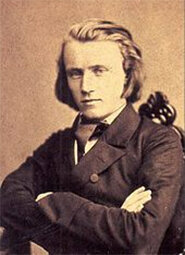As our journey continues, let us explore Brahms’ (1833-1897) Three Intermezzi, Op.117. Written together with Fantasien Op.116 during a short stay at Bad Ischl, this set is even more introspective compared to the previous opus. When Brahms sent this set of Intermezzi to Clara Schumann, she claimed, “in these pieces I at last feel musical life stir once again in my soul”. Perfused with melancholy and grief, these three Intermezzi were regarded as “three lullabies for my sorrows” by the composer.

Johannes Brahms © Wikipedia
Schlaf sanft mein Kind, schlaf sanft und schön!
Mich dauert’s sehr, dich weinen sehn.
(Original text: Baloo, my babe, lie still and sleep. It grieves me sore to see thee weep.)

Grigory Sokolov © Wikipedia
Radu Lupu’s rendition of this piece was intimate and deeply personal. With a seemingly “hammerless” touch, he let the music breathe and flow naturally. The emotions conveyed were restrained, particularly when compared to other versions, which was indeed in line with Brahms’ personality. Sokolov here presented a sincere reading, coupled with carefully weighed and voiced chords and gorgeous tone production. It seemed that Sokolov attempted to extract as much as possible from the piece, as evidenced by his more emotional playing.

Radu Lupu © ichef.bbci.co.uk
Lupu’s playing here was nuanced and sensitive, though for me the emotional depth achieved in the previous piece was superior to this. Sokolov’s reading of this piece was unfailingly impressive, in which deep emotions were conjured with suppressed passion. He succeeded in revealing Brahms’ inner emotional world with his immaculate palette of tone colours.
The final Intermezzo of this triptych in C-sharp minor (Andante con moto) was written in a ballade-like style with a stark atmosphere. It is thought that this piece was inspired by Herder’s poetic lines “Oh woe! Oh woe, deep in the valley…”. The section in which the melodic line moves to the inner voice is heartbreakingly beautiful, expressing nostalgia, sorrow and regret. As we reach the central section, the music sounds more optimistic with some heart-warming and luscious moments. It soon becomes increasingly agitating until it finally quiets down to the transition back to the first theme.
Here, Lupu pulled off a very musical performance, in which the first section had much motility. Like other pieces in this set, this Intermezzo showed restrained emotions under Lupu’s hands. On the other hand, Sokolov’s was more passionate, where emotions were more pronounced. At times, his playing reached monologue-like intensity, allowing us to hear the outpouring of the composer’s heart.
